国画历史知识英文版-CNArtGallery
- 格式:pdf
- 大小:328.95 KB
- 文档页数:3
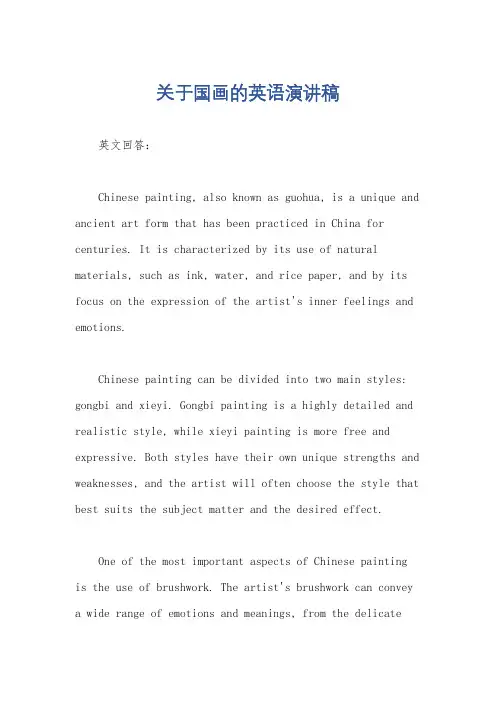
关于国画的英语演讲稿英文回答:Chinese painting, also known as guohua, is a unique and ancient art form that has been practiced in China for centuries. It is characterized by its use of natural materials, such as ink, water, and rice paper, and by its focus on the expression of the artist's inner feelings and emotions.Chinese painting can be divided into two main styles: gongbi and xieyi. Gongbi painting is a highly detailed and realistic style, while xieyi painting is more free and expressive. Both styles have their own unique strengths and weaknesses, and the artist will often choose the style that best suits the subject matter and the desired effect.One of the most important aspects of Chinese paintingis the use of brushwork. The artist's brushwork can convey a wide range of emotions and meanings, from the delicateand subtle to the bold and powerful. The artist will often use different types of brushes to create different effects, and the way in which the brush is held and moved can also affect the outcome of the painting.Chinese painting is also known for its use of calligraphy. Calligraphy is the art of writing Chinese characters, and it is considered to be an essential part of Chinese painting. The artist will often use calligraphy to add inscriptions or signatures to their paintings, and the style and quality of the calligraphy can add to the overall impact of the work.Chinese painting has a long and rich history, and it has been influenced by a wide range of factors, including Chinese philosophy, religion, and literature. Chinese painting has also been influenced by other cultures, such as Buddhism and Islam, and it has in turn influenced the development of painting in other countries, such as Japan and Korea.Today, Chinese painting continues to be a vibrant andthriving art form. It is practiced by artists all over the world, and it is appreciated by people of all cultures. Chinese painting is a beautiful and expressive art form that has the power to move and inspire.中文回答:中国画,又称国画,是中国传承了数个世纪的独特而古老的艺术形式。
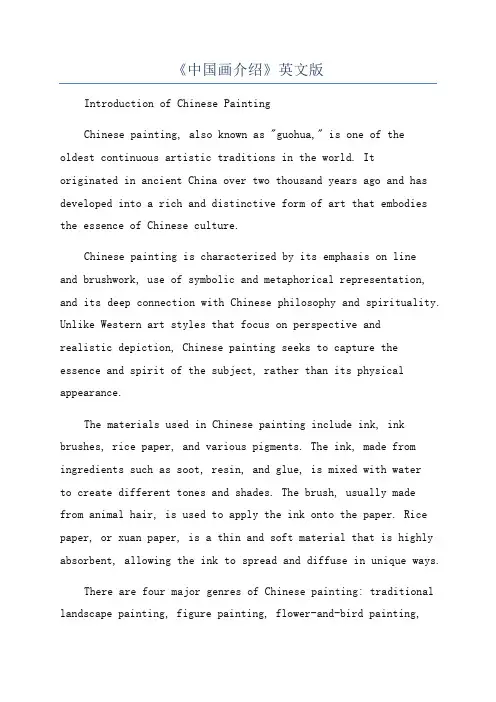
《中国画介绍》英文版Introduction of Chinese PaintingChinese painting, also known as "guohua," is one of theoldest continuous artistic traditions in the world. Itoriginated in ancient China over two thousand years ago and has developed into a rich and distinctive form of art that embodies the essence of Chinese culture.Chinese painting is characterized by its emphasis on lineand brushwork, use of symbolic and metaphorical representation, and its deep connection with Chinese philosophy and spirituality. Unlike Western art styles that focus on perspective andrealistic depiction, Chinese painting seeks to capture the essence and spirit of the subject, rather than its physical appearance.The materials used in Chinese painting include ink, ink brushes, rice paper, and various pigments. The ink, made from ingredients such as soot, resin, and glue, is mixed with waterto create different tones and shades. The brush, usually made from animal hair, is used to apply the ink onto the paper. Rice paper, or xuan paper, is a thin and soft material that is highly absorbent, allowing the ink to spread and diffuse in unique ways.There are four major genres of Chinese painting: traditional landscape painting, figure painting, flower-and-bird painting,and calligraphy. Landscape painting, or shanshui hua, is considered the highest form of Chinese painting. It seeks to depict the harmony between man and nature, with mountains, rivers, and trees as the primary subjects. The landscape is often depicted in a minimalist and symbolic manner, using brushstrokes that convey the energy and movement of nature.Figure painting, or renwu hua, focuses on the human figure and its emotional expression. It can be categorized intoportrait painting, which aims to capture the likeness and personality of the subject, and narrative painting, which tells stories or depicts scenes from history and mythology.Flower-and-bird painting, or huaniao hua, is a popular genre that focuses on the depiction of flowers, birds, and other natural elements. It is often associated with themes of beauty, elegance, and harmony. This genre is known for its delicate and intricate brushwork, capturing the subtle details and texturesof the subject.。
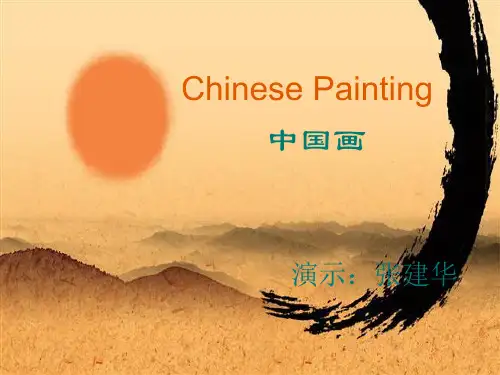
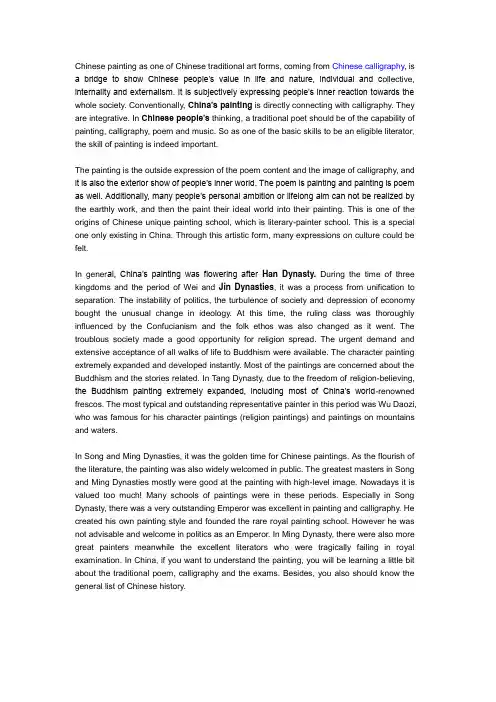
Chinese painting as one of Chinese traditional art forms, coming from Chinese calligraphy, is a bridge to show Chinese people’s value in life and nature, individual and c ollective, internality and externalism. It is subjectively expressing people’s inner reaction towards the whole society. Conventionally, China’s painting is directly connecting with calligraphy. They are integrative. In Chinese people’s thinking, a traditional poet should be of the capability of painting, calligraphy, poem and music. So as one of the basic skills to be an eligible literator, the skill of painting is indeed important.The painting is the outside expression of the poem content and the image of calligraphy, and it is also the exterior show of people’s inner world. The poem is painting and painting is poem as well. Additionally, many people’s personal ambition or lifelong aim can not be realized by the earthly work, and then the paint their ideal world into their painting. This is one of the origins of Chinese unique painting school, which is literary-painter school. This is a special one only existing in China. Through this artistic form, many expressions on culture could be felt.In gener al, China’s painting was flowering after Han Dynasty.During the time of three kingdoms and the period of Wei and Jin Dynasties, it was a process from unification to separation. The instability of politics, the turbulence of society and depression of economy bought the unusual change in ideology. At this time, the ruling class was thoroughly influenced by the Confucianism and the folk ethos was also changed as it went. The troublous society made a good opportunity for religion spread. The urgent demand and extensive acceptance of all walks of life to Buddhism were available. The character painting extremely expanded and developed instantly. Most of the paintings are concerned about the Buddhism and the stories related. In Tang Dynasty, due to the freedom of religion-believing, the Buddhism painting extremely expanded, including most of China’s world-renowned frescos. The most typical and outstanding representative painter in this period was Wu Daozi, who was famous for his character paintings (religion paintings) and paintings on mountains and waters.In Song and Ming Dynasties, it was the golden time for Chinese paintings. As the flourish of the literature, the painting was also widely welcomed in public. The greatest masters in Song and Ming Dynasties mostly were good at the painting with high-level image. Nowadays it is valued too much! Many schools of paintings were in these periods. Especially in Song Dynasty, there was a very outstanding Emperor was excellent in painting and calligraphy. He created his own painting style and founded the rare royal painting school. However he was not advisable and welcome in politics as an Emperor. In Ming Dynasty, there were also more great painters meanwhile the excellent literators who were tragically failing in royal examination. In China, if you want to understand the painting, you will be learning a little bit about the traditional poem, calligraphy and the exams. Besides, you also should know the general list of Chinese history.The painting above is one of China top-ten classic paintings in Chinese ancient days. it is the masterpiece of great painter, Gu Kaizhi, the painter lived in East Jin Dynasty. This long painting is named Luoshenfutu. It is focusing on the goddess of Luo River with the hisotry of more than 1600 years.^ top ^This is the masterpiece created by Wu Daozi who was the great master in Tang Dynasty. He was good at the painting of buddhisitic stories or fairtales. Besides he also did well in emperor painting. He was an outstanding painting on religion. His name is also associated with Taoism. This painting is Tianwangsozitu.This is the masterpiece of Zhan Zixu, another great master of painting in Tang Dynasty. It is also one of China's classic painting of old days . it is focusng on the landscape of their travel destination, when they were visiting in Spring.^ top ^This is a rare painting created by one emperor of Song Dynasty.This is another classic painting of SongDynasty.It is highlighted for its historical importance. Painting in Song Dynasty was emphasized incomparably, because the emperor loved painting very much.^ top ^The paintings above are the most famous one in China's history. Currently it is the national treasure. It was created in Song Dynasty. The painter was Zhang Zeduan. It was the first painting to depict the daily life of commoners in Bianliang, the capital of Song Dynasty . It shows the prosperity of economy at that time.^ top ^These two painting are focusing on the landscape of nature meanwhile also mixed with some painters imagination on thir ideal image. there were both created in Song Dynasty.The pictures above all created by the literator in Ming Dynasty. Actually it was a progressive way from Tang Dynasty to Song Dynasty.^top^The paintings above generally inherited the traditional features of Ming Dynasty. It is diversified and colorful! Since Song Dynasty, Chinese culture vividlyrevealed in the aspect of painting inclined to the elite culture or the elegant literator's taste. These paintings were unprecedentedly popularized in Ming and Qing Dynasties. It was a fashion in pursuit of self-improvementThe paintings above were all created by modern Chinese painters. They are theauthorized representatives of the modern Chinese painting and the leaders of China's art.。
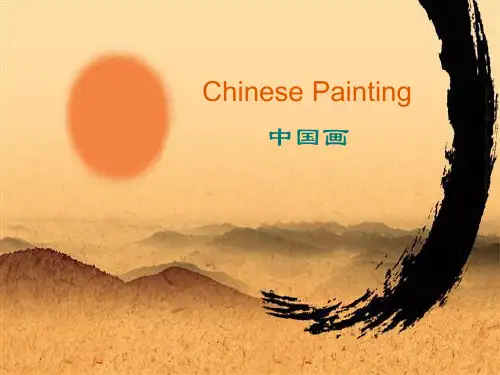
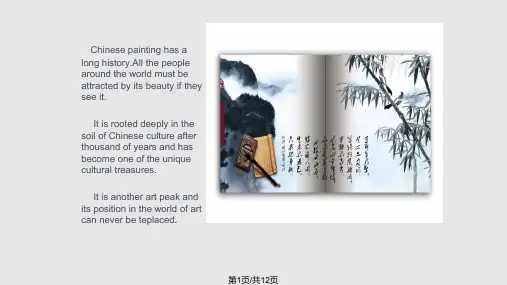
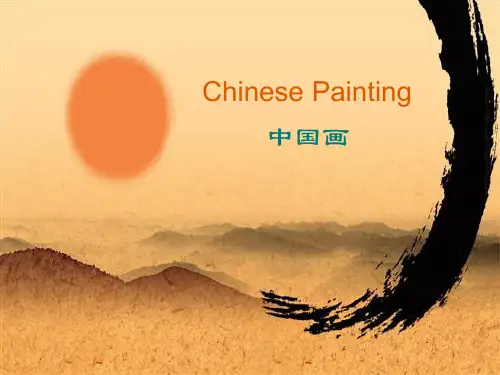
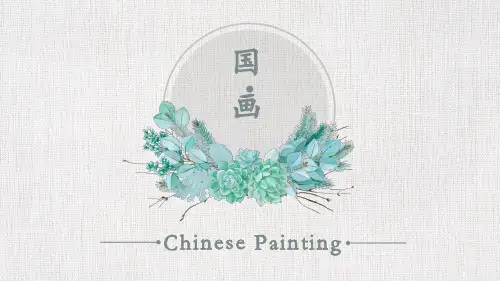
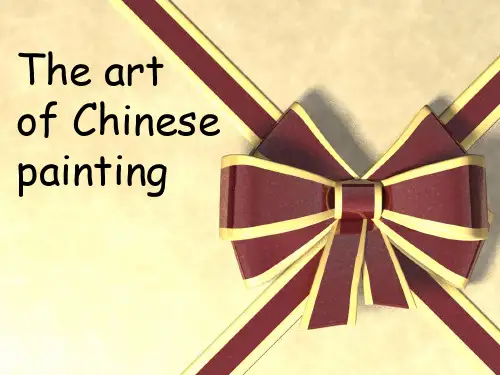
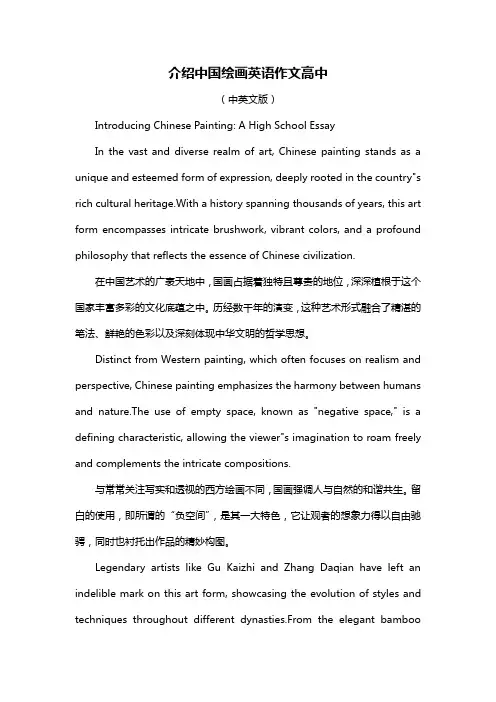
介绍中国绘画英语作文高中(中英文版)Introducing Chinese Painting: A High School EssayIn the vast and diverse realm of art, Chinese painting stands as a unique and esteemed form of expression, deeply rooted in the country"s rich cultural heritage.With a history spanning thousands of years, this art form encompasses intricate brushwork, vibrant colors, and a profound philosophy that reflects the essence of Chinese civilization.在中国艺术的广袤天地中,国画占据着独特且尊贵的地位,深深植根于这个国家丰富多彩的文化底蕴之中。
历经数千年的演变,这种艺术形式融合了精湛的笔法、鲜艳的色彩以及深刻体现中华文明的哲学思想。
Distinct from Western painting, which often focuses on realism and perspective, Chinese painting emphasizes the harmony between humans and nature.The use of empty space, known as "negative space," is a defining characteristic, allowing the viewer"s imagination to roam freely and complements the intricate compositions.与常常关注写实和透视的西方绘画不同,国画强调人与自然的和谐共生。
Chinese Painting Knowledge http:/www.cnartgallery.com Provide by http://www.cnartgallery.com Chinese Painting - History (Provide by http://www.cnartgallery.com) Early Imperial China (221 BC-AD 220)
In imperial times (beginning with the Eastern Jin Dynasty), painting and calligraphy in China were the most highly appreciated arts in court circles and were produced almost exclusively by amateurs--aristocrats and scholar-officials--who had the leisure time necessary to perfect the technique and sensibility necessary for great brushwork. Calligraphy was thought to be the highest and purest form of painting. The implements were the brush pen, made of animal hair, and black inks made from pine soot and animal glue. In ancient times, writing, as well as painting, was done on silk. However, after the invention of paper in the 1st century AD, silk was gradually replaced by the new and cheaper material. Original writings by famous calligraphers have been greatly valued throughout China's history and are mounted on scrolls and hung on walls in the same way that paintings are. Period of division (220-581)
During the Six Dynasties period (220-589), people began to appreciate painting for its own beauty and to write about art. From this time we begin to know about individual artists, such as Gu Kaizhi. Even when these artists illustrated Confucian moral themes - such as the proper behavior of a wife to her husband or of children to their parents - they tried to make the figures graceful. Sui and Tang dynasties (581-907)
During the Tang Dynasty, figure painting flourished at the royal court. Artists such as Zhou Fang showed the splendor of court life in paintings of emperors, palace ladies, and imperial horses. Figure painting reached the height of elegant realism in the art of the court of Southern Tang (937-975). Most of the Tang artists outlined figures with fine black lines and used brilliant color and elaborate detail. However, one Tang artist, the master Wu Daozi, used only black ink and freely painted brushstrokes to create ink paintings that were so exciting that crowds gathered to watch him work. From his time on, ink paintings were no longer thought to be preliminary sketches or outlines to be filled in with color. Instead they were valued as finished works of art. Beginning in the Tang Dynasty, many paintings were landscapes, often shanshui (山水, "mountain water") paintings. In these landscapes, monochromatic and sparse (a style that is collectively called shuimohua), the purpose was not to reproduce exactly the appearance of nature (realism) but rather to grasp an emotion or atmosphere so as to catch the "rhythm" of nature. Song and Yuan dynasties (960-1368) Chinese Painting Knowledge http:/www.cnartgallery.com Provide by http://www.cnartgallery.com In the Song Dynasty period (960-1279), landscapes of more subtle expression appeared; immeasurable distances were conveyed through the use of blurred outlines, mountain contours disappearing into the mist, and impressionistic treatment of natural phenomena. Emphasis was placed on the spiritual qualities of the painting and on the ability of the artist to reveal the inner harmony of man and nature, as perceived according to Taoist and Buddhist concepts. One of the most famous artists of the period was Zhang Zeduan, painter of Along the River During the Qingming Festival. Yi Yuanji achieved a high degree of realism painting animals, in particular monkeys and gibbons.
During the Southern Song period (1127-1279), court painters such as Ma Yuan and Xia Gui used strong black brushstrokes to sketch trees and rocks and pale washes to suggest misty space.
While many Chinese artists were attempting to represent three-dimensional objects and to master the illusion of space, another group of painters pursued very different goals. At the end of Northern Song period, the poet Su Shi and the scholar-officials in his circle became serious amateur painters. They created a new kind of art in which they used their skills in calligraphy (the art of beautiful writing) to make ink paintings. From their time onward, many painters strove to freely express their feelings and to capture the inner spirit of their subject instead of describing its outward appearance.
The "Four Generals of Zhongxing" painted by Liu Songnian during the Southern Song Dynasty. Yue Fei is the second person from the left. It is believed to be the "truest portrait of Yue in all extant materials."